Cattle and goats
The intensive breeding of milking animals (cattle and goats) offers a series of pratical applications of gearboxes, that allows to manage and organize orderly the livestock and to mantain a good level of welfare for animals. In fact, the production of dairy product is a fundamental element, it is important to not stress the animal because it causes contractions in production that affect the company economically.
Customized and automated housing types
Inside the plant, the animals are confined in controlled spaces, where their vital functions are monitored. The stable must be of adequate size, must have constant ventilation to allow air exchange and must mantain the optimal temperature for the animal both in summer and in winner. This is possible thanks to the thermoregulation.
It is very comfortable when the automatic windows opening is managed by gearboxes. In fact, a very common application of gerarboxes is to manage the opening and closing of windows in greenhouse and farm to guarantee the correct air exchange. Automated management makes it possible to replace manual interventions, where man's access is made difficult by the buildings' architecture. The ideal product for this work is the double-stage worm gear reducer associated with a limit switch device. This has the purpose of controlling the action range of gearbox by a microswitch that, when the right position is reached, disables the power and stops the movement of the gearbox. This device allows the user to set the right intervention times adaptable to the multiple requirements.
It is possible to insert a timer in the electrical panel of the application, to comfortably program all the operations necessary in the most suitable times. The limit stop device can be applied on a single worm gear reducer with a minimum ratio of 1: 5 up to a maximum ratio of 1: 10.000 in the case of two worm gearboxes. Varvel offers international customers both worm gearboxes with a predisposition for mounting the end-of-stroke device and the gearbox with the limit switch already installed. This is an optimal solution as it does not affect noise, energy consumption or the performance of the gearbox and the final application.
Automated massaging brushes thanks to gearboxes
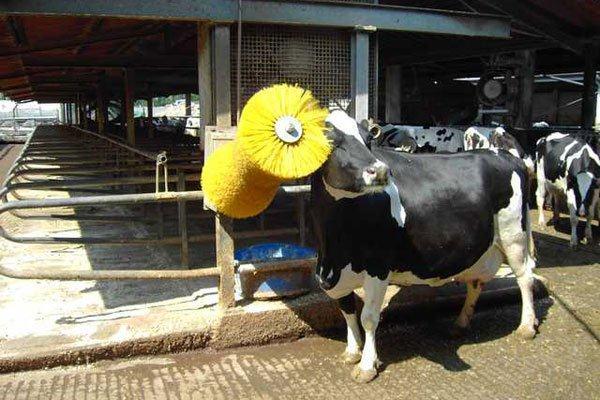
A clean and well-groomed cow contributes to better herd health, and to do this, rotating brushes have been installed in the stalls. The animals can rub on this brushes, positioned in dedicated areas inside the stable. They are activated and deactivated automatically when animal pass, stimulating them to a greater production, without the need of any intervention by the breeder. The brushes are hourglass shaped, and this guaranteee the right pressure and ergonomic adherence to the shape of the animal. They start rotating when the animals touch them, and the rotation is once in clockwise and once in counterclockwise direction, to limit wear, allowig bristles to mantain the correct hardness longer. The brushes stimulated the circulation of blood in the animal, keeping it clean and calm with a pleasant massage.
Among the large number of applications, where the gearboxes made in Varvel can be applied, are including this automatic brushing systems for dairy herds. Livestock farmers all over the world are committed to greater animal wellbeing as well as compliance with the strict standards regulating the industry. These are exactly the needs that Varvel's top quality solutions satisfy. In recent years, it has become increasingly clear that dairy cows produce more milk if they are brushed regularly.
The cleaning of the stables is entrusted to machinery and systems that use gearboxes
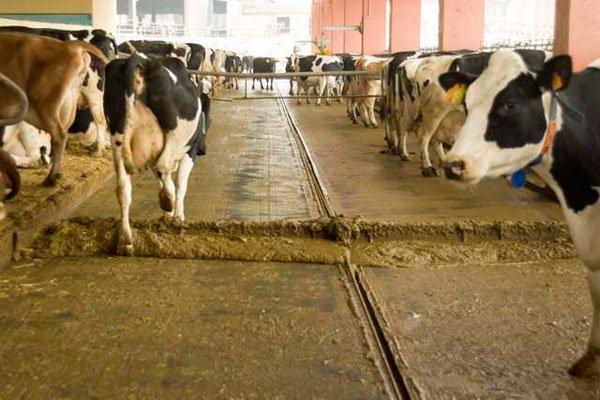
The methods to clean the stables are divided into mechanical systems and recirculation systems:
- To clean the fixed housing, floor scraves are installed in the system. Floor scrapers can keep cattle sheds clean. Driven by gearboxes to ensure slow movement and eliminate all risk of injury to the animals, these operate at fixed intervals, traversing the whole length of the floor to scrape manure into a drop pit ready for recycling as fertiliser.
- Scrapers maneuvered directly by the operatos
- Cracked floor with collection pits and vehiculation of dejections by recirculation or by overflow.
- Surface recirculation with clarified sewage.
Automated feeding systems assisted by gearboxes
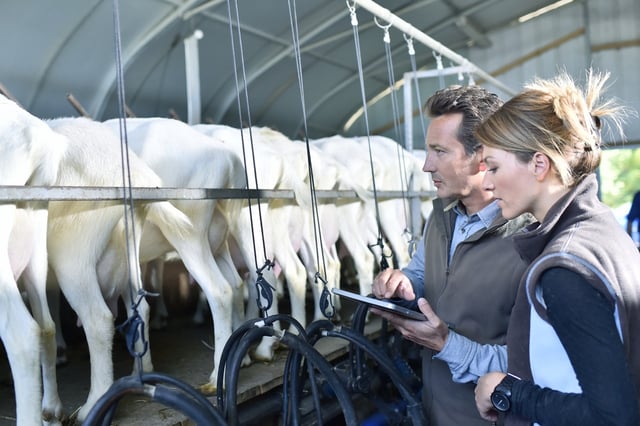
Feed types may vary, they may be provided at different time, or different feeds may be provided depending on the intended use of the animals. However, It is important that all animals are given access to the feed at the same time, especially in the case of cow, to avoid hierarchical struggles that could injure or damage the breasts. Therefore the moment of the meal is very delicate, so a precise and orderly organization is need.
In case of fixed housing (animals that always remain stationary each in their space) the possible technologies to provide the food to animals are different, but basically it is still managed by feed drops, at will or planned, of the same type or of different feeds, solid or liquid.
On the other hand, there are different types of feeding for smaller animals, such as sheep and goats. In this case it is the animals that move and change position when it is time for nutrition. To avoid agitation due to the high density of specimens, there are machines that automatically involve them at the station, making them pass one at a time and rotating to make a base available to everyone. This technology allows animals to be monitored, but it is necessary for the system to work consistently with their time and needs. To do this we use gearboxes that can give the right rhythm to the machinery in safety, and to safeguard the welfare of the animals.
Different milking parlors that can be adapted to every need
Even the milking parlor is equipped with a feeding department, so that each specimen has its own manger, where it is blocked until operations are completed. The milking models are different, they are divided in milking at the post office and milking in the room.
1) Milking at the post
- Bucket or trolley plants: They are suitable for small farms and for infirmaries and birth areas of large farms. In the case of bucket models, the placement of the vacuum pump in a specific room is envisaged, as well as the installation of a fixed pipe with taps. The productivity of the work of these plants is rather low, since the time required to empty the buckets and the movement of the groups from one cow to the next are very high. However, given the characteristics of the farms that use them (family, part-time, etc.) and the limited number of animals to be milked, this is not a priority element of choice. In the case of medium-large farms, to reduce the working time, it is good to have the drums along the path made by the milker.
- Plants with a leased dairy line: In ths case working times are reduced because the movements necessary to empty the buckets are eliminated, but the way in which the milking operation is carried out can affect the quality of the milk. In fact, by starting to milk the cows that are close to the terminal vessel and proceeding towards the opposite extreme, a better quality product is obtained and washing is facilitated with respect to the opposite case, in which milk is stagnated and consequent increase of the charge total bacterial
2) Milking in the room: The second milking category is usually used in larger plants. In fact, milking in the hall reduces and simplifies the work of the milker considerably. The only task of physical commitment is to raise the group of teaspoons (of the mass of 2.5-3.5 kg) to apply it to the breast at a rate of 20 to 200 times per hour, depending on the type of implant. Turning from manual milking to room milking, productivity increases 10 times, while the operator's energy expenditure is halved. There are several techniques of milking in the room:
- Tandem milking parlor: This is a suitable facility for individual cows' care. In it the cows move individually towards the stalls, entering and exiting through gates open and closed manually or automatically by means of pneumatic or electronic devices. The cows are milked individually, so those with high milking time do not cause problems waiting for others. However, since the cows are placed in a row, the distance that the milker has to travel (two successive udders are at a distance of about 2.5 m) is quite large and their productivity and quality of work are affected. Tandem rooms have been mechanized in various ways: in the waiting room, opening of the electric or mechanical gates and pushers, with an electronic production measurement systems connected to automatic detachment devices, in turn connected to the gate opening command, with automatic feeders
- Herringbone milking parlor: It is the most widespread type of plant in Italian free-housing breedings, as it allows to obtain high work productivity, thanks to the simplification of the work. In fact, the animals are introduced in the milking room in groups, reducing thus the operator's movements. However, this can cause errors in the execution of the routine; a long wait before the attack of the groups prevents to fully exploit the effect of the oxytocinic discharge. Therefore, variations in milk production found with these plants are often attributable to the routine adopted. The rooms made in this way have very high surfaces to allow the milked animals to move towards the stable once milking is finished. The achievable productivity results in the order of 30-40 milestones per hour man.
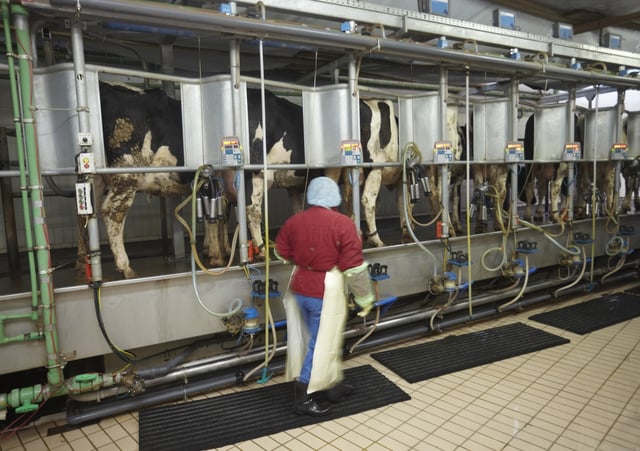
- Comb milking room: It is characterized by the right-angle arrangement of the animals with respect to the milker's pit. Milking groups are applied from behind and not sideways as in all other cases. The advantage of this solution is the greater compactness of the plant, as well as a better flow of animals entering and leaving. Among the disadvantages, however, must be considered the poor or no vision of the breast and the irregular positioning of milking groups not specifically studied.
- Trigonal and polygonal milking parlor: This is a variant of the classic herringbone pattern, consisting of the division of animals into three sectors (instead of increasing the number of groups of the two rows). The aim is to leave more time for milking the "slower" cows, reducing the waiting time of the other animals to a minimum. In fact, with this configuration, 2/3 of the animals are milking, while the remaining third is in circulation (leaves and enters the hall). At the same number of milking groups, the theoretical increase in productivity is between 16 to 25%. It only makes sense if full use is made of automatisms to facilitate human work. The advantage obtained during milking, however, can be lost if the path of the animals entering and leaving is not carefully studied.
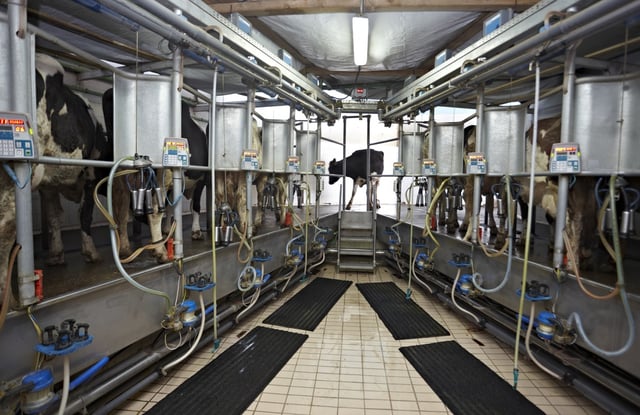
- Rotary plants: A rotary carousel helps to increase the productivity of the company, guaranteeing greater yield by delicately treating the items. No other milking parlor solution combines economic aspects and stress-free herd management as valid as a rotary press. After the cow has entered the platform, the milker commands the start of the rotation; the movement stops when the path completed is equal to the width of the stall. The attendant remains practically stationary. The cow rises on the platform in a radial position, while, consequently, the milking takes place from behind. Operators (usually 2) work outside the platform.
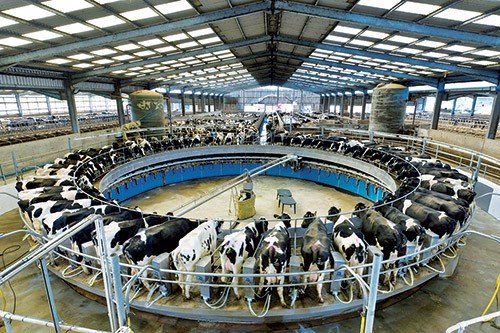
Gearboxes are one of the key technologies to allow the operation of breeding of this type. The automation of these systems allows a comfortable and easy handling of the animals, keeping them quiet and guiding them in their paths. Gearboxes that produce little noise and few vibrations are essential to ensure that the machine can work in conctact with the animal without stressing them.



